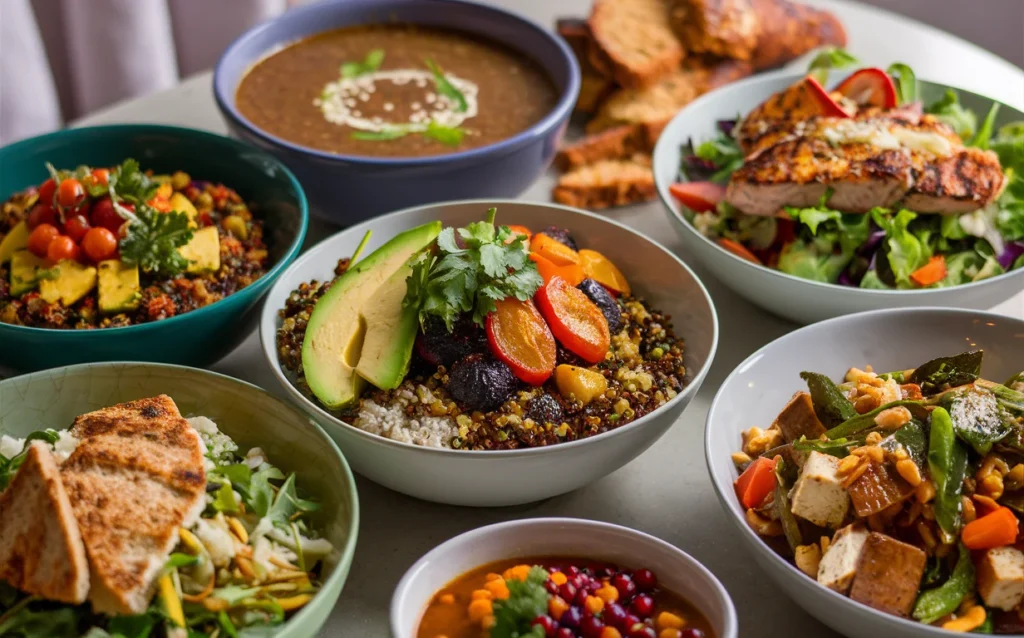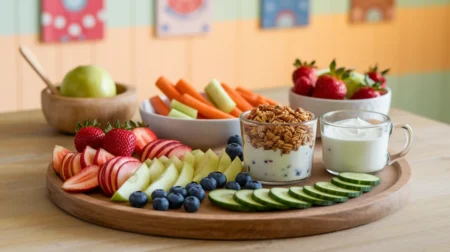Cheap Whole Foods Meals
Key Takeaways
- Whole foods meals can be both nutritious and affordable when planned thoughtfully.
- Using seasonal produce and bulk purchases can reduce costs significantly.
- Creating a weekly meal plan focused on whole foods helps you stick to your budget without sacrificing health.

What Are Whole Foods?
Whole foods are foods that are as close to their natural form as possible, without any additives or minimal processing. Eating whole foods offers numerous health benefits, such as increased energy, improved digestion, and better overall nutrition. But contrary to popular belief, you don’t have to break the bank to enjoy a whole foods diet. With the right ingredients and recipes, you can create cheap whole foods meals that are both delicious and affordable.
Tips for Eating Whole Foods on a Budget
Here are some strategies to help you enjoy whole food recipes on a budget:
- Buy in Bulk: Foods like oats, rice, beans, and lentils are inexpensive and nutritious, and buying them in bulk can save even more money.
- Focus on Seasonal Produce: Seasonal fruits and vegetables are often cheaper and more flavorful. In-season items like root vegetables in the winter and berries in the summer are great options.
- Cook at Home: Preparing meals from scratch can save money compared to buying pre-packaged foods. Whole foods meals are easy to prepare and allow for a lot of variety.
Affordable Whole Foods Meal Ideas
Here are some cheap whole foods meals you can try for breakfast, lunch, and dinner:
1. Oatmeal with Fresh Fruit
Oats are one of the most affordable whole foods available. Top your oatmeal with seasonal fruit like apples, bananas, or berries for a nutritious start to your day. Add a sprinkle of nuts or seeds for extra protein.
2. Chickpea and Vegetable Stir-Fry
Chickpeas are an excellent source of protein and fiber. Combine them with your favorite vegetables like bell peppers, broccoli, and carrots for a filling stir-fry. Serve over brown rice for a balanced meal.
3. Lentil Soup
Lentils are another affordable source of protein. Cook lentils with onions, garlic, carrots, and celery for a hearty soup. Season with herbs like thyme and rosemary for added flavor. This meal is perfect for meal prepping as it can be stored for a few days.
4. Sweet Potato and Black Bean Tacos
Sweet potatoes and black beans are inexpensive and nutrient-dense. Roast sweet potatoes with spices like cumin and paprika, then serve them in a tortilla with black beans, salsa, and avocado.
5. Vegetable and Quinoa Salad
Quinoa is a versatile grain that pairs well with various vegetables. Combine quinoa with chopped cucumbers, tomatoes, bell peppers, and a lemon vinaigrette for a refreshing and filling salad.
6. Whole Wheat Pasta with Marinara Sauce
Whole wheat pasta is a budget-friendly option that adds fiber to your meal. Toss with a homemade marinara sauce made from canned tomatoes, garlic, and basil. Add fresh or frozen vegetables to boost the nutritional value.
7. Baked Chicken with Roasted Vegetables
If you’re looking for a satisfying dinner, bake a few chicken thighs or breasts and serve them with roasted vegetables like carrots, potatoes, and Brussels sprouts. Drizzle with olive oil and your favorite herbs before baking.
Weekly Whole Foods Meal Plan on a Budget
Planning your meals can help you make the most of your grocery budget. Here’s a simple whole foods meal plan that’s budget-friendly and delicious:
Monday
- Breakfast: Overnight oats with bananas and walnuts
- Lunch: Chickpea and vegetable stir-fry with brown rice
- Dinner: Lentil soup with a side salad
Tuesday
- Breakfast: Smoothie with spinach, banana, and almond milk
- Lunch: Sweet potato and black bean tacos
- Dinner: Quinoa salad with mixed vegetables
Wednesday
- Breakfast: Whole grain toast with avocado and a side of fruit
- Lunch: Leftover lentil soup
- Dinner: Baked chicken with roasted carrots and potatoes
Thursday
- Breakfast: Oatmeal with apples and a dash of cinnamon
- Lunch: Whole wheat pasta with marinara sauce and steamed broccoli
- Dinner: Stir-fried vegetables with tofu over brown rice
Friday
- Breakfast: Yogurt with berries and a sprinkle of granola
- Lunch: Leftover quinoa salad
- Dinner: Chickpea curry with steamed rice
Saturday
- Breakfast: Smoothie bowl with mixed fruits and seeds
- Lunch: Black bean and veggie tacos
- Dinner: Vegetable stir-fry with rice noodles
Sunday
- Breakfast: Scrambled eggs with spinach and whole wheat toast
- Lunch: Vegetable lentil soup
- Dinner: Quinoa and roasted vegetable bowl
Conclusion
Eating cheap whole foods meals doesn’t have to be complicated or expensive. By focusing on affordable ingredients like oats, beans, lentils, and seasonal produce, you can create meals that are not only budget-friendly but also nutritious and satisfying. Planning your meals ahead of time and cooking from scratch are great ways to enjoy whole foods without overspending. Start experimenting with these ideas to make delicious, affordable meals for you and your family.
FAQs
Q: Are whole foods more expensive than processed foods?
A: Not necessarily. Buying whole foods like beans, rice, and fresh produce can be more affordable than purchasing processed foods, especially when bought in bulk.
Q: How can I make whole foods meals more filling?
A: To make meals more filling, include a source of protein like beans, lentils, chicken, or tofu, and pair them with whole grains such as brown rice or quinoa.
Q: What are the benefits of eating whole foods on a budget?
A: Eating whole foods on a budget can improve your health by reducing your intake of added sugars, preservatives, and unhealthy fats. It also encourages more mindful meal planning and cooking habits.
Q: Can I freeze whole foods meals?
A: Absolutely! Many whole foods meals, like soups, stews, and cooked grains, can be frozen and enjoyed later. This can save time and help reduce food waste.










